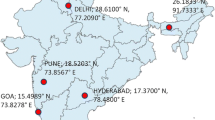Abstract
Antarctica is a unique and challenging environment where members of expeditions face a range of conditions not normally experienced. Ultraviolet (uv) radiation levels show marked variation during the year. The 25-hydroxy metabolite of vitamin D [25(OH)D] is largely produced by sunlight and shows a yearly variation in concentration that corresponds to uv radiation levels. The active metabolite 1,25-dihydroxyvitamin D [1,25(OH)2D] does not generally show any such variation provided 25(OH)D concentrations are sufficient. Previous studies have shown a seasonal variation in 25(OH)D with a significant winter drop. No other study of 1,25(OH)2D has been reported on members of Antarctic expeditions. A group of 19 men wintering at Davis Station (68° 34′ S) had four blood samples taken at 3-monthly intervals beginning in the Antarctic summer. Analysis for 25(OH)D showed a drop in concentration for each of the latter three sampling periods (P < 0.005). This correlated with uv radiation levels and would suggest that endogenous production of 25(OH)D ceases for at least the duration of the Antarctic winter. There were no significant alterations in 1,25(OH)2D or calcium concentrations over the same period. Providing that individuals with pre-existing vitamin D deficiencies are detected before departure for Antarctica and missions are limited in duration, clinical deficiency is unlikely to occur.
Similar content being viewed by others
References
Chesney RW, Rosen JF, Hamstra AJ, Smith C, Mahaffey K, DeLuca HF (1981) Abscence of seasonal variation in serum concentrations of 1,25-dihydroxyvitamin D despite a rise in 25-hydroxy vitamin D in summer. J Clin Endocrinol Metab 53:139–142
Dean B, Kolavcic MS, Wark JD, Harrison LC (1988) Chromatography of serum on Sep-pak C18 corrects falsely elevated vitamin D metabolite levels measured by protein binding assay. Clin Chim Acta 176:169–178
DeLuca HF, Schnoes HK (1976) Metabolism and mechanism of action of vitamin D. Annu Rev Biochem 45:631–666
Fairney A, Fry J, Lipscomb A (1979) The effect of darkness on vitamin D in adults. Postgrad Med J 55:248–250
Griffiths P, Fairney A (1988) Vitamin D metabolism in polar vertebrates. Comp Biochem Physiol 91B:511–516
Griffiths AP, Fairney A (1989) Effect of phototherapy on serum 25-hydroxyvitamin D in the Antarctic. Eur J Appl Physiol 59:68–72
Haddad JG (1992) Vitamin D-solar rays, the milky way, or both? N Engl JM 1213–1215
Hicks, CR (1982) Fundamental concepts in design of experiments. Holt, Reinhart and Winsden, New York
Juttmann JR, Visser TL, Buurman C, de Kam E, Birkenhager JC (1981) Seasonal fluctuations in serum concentrations of vitamin D metabolites in normal subjects. BMJ 282:1349–1352
Lugg DJ (1977) Physiological adaptation and health of an expedition in Antarctica with comment on behavioural adaptation. ANARE Sci Rep(B)4 no.126. Australian Antarctic Division, Hobart
McKenna MJ (1992) Differences in vitamin D status between countries in young adults and the elderly. Am J Med 93:69–77
McLauchlin M, Raggatt PR, Fairney A, Brown DJ, Lester E, Willis MR (1974) Seasonal variations in serum 25-hydroxycholecalciferol in healthy people. Lancet I: 536–538
Shigeno C, Morita R, Dokoh S, Fukunaga M, Yamamoto I, Hino M, Yamada K, Torizuka K, Minami T (1982) Measurement of serum PTH, CT, and vitamin D metabolites in members of the 19th Japanese Antarctic research expedition. In: Norman AW, Schaefer K, Grigoleit HG, Herrath DV (eds) Vitamin D, chemical, biochemical and clinical endocrinology. de Gruyter, Berlin, pp 677–679
Stamp TCB, Round JM (1974) Seasonal changes in human plasma levels of 25-hydroxyvitamin D. Nature 247:563–565
Taylor D McD (1992) Modification of the type of dietary fat at an Antarctic station: impact on cardiovascular risk factors. ANARE Research Notes 86. Australian Antarctic Division, Hobart
Tjellesen L, Christiansen C (1983) Vitamin D metabolites in normal subjects during one year. A longitudinal study. Scand J Clin Lab Invest 43: 85–89
Wilske J (1993) Plasma concentrations of 25-hydroxyvitamin D3 (calcifediol) as an indicator of ultraviolet radiation. Arct Med Res 52:166–169
Author information
Authors and Affiliations
Rights and permissions
About this article
Cite this article
Pitson, G.A., Lugg, D.J. & Roy, C.R. Effect of seasonal ultraviolet radiation fluctuations on vitamin D homeostasis during an Antarctic expedition. Europ. J. Appl. Physiol. 72, 231–234 (1996). https://doi.org/10.1007/BF00838644
Accepted:
Issue Date:
DOI: https://doi.org/10.1007/BF00838644




